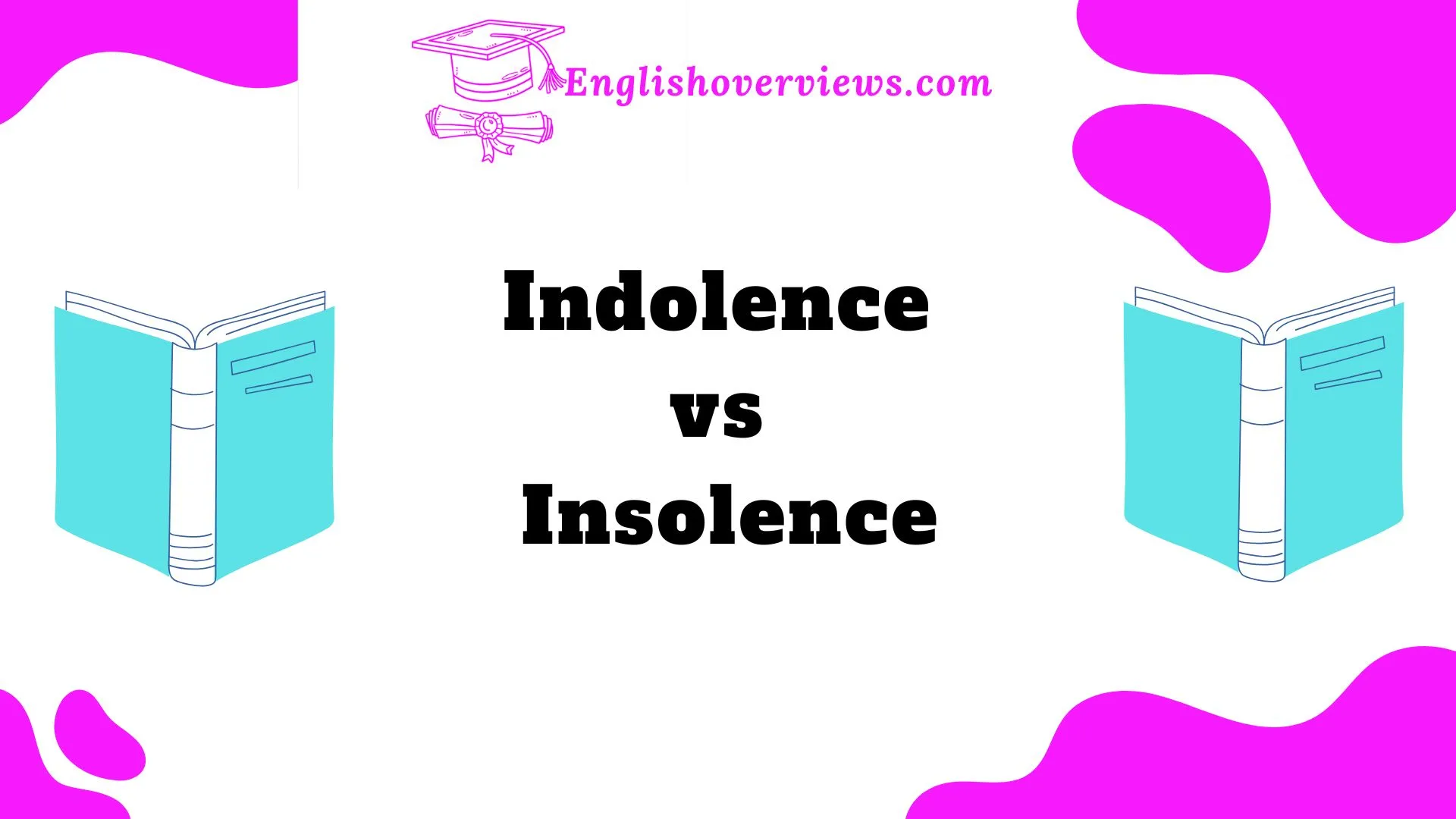Ever found yourself mixing up “indolence” and “insolence”? You’re not alone. These two words sound somewhat similar but have entirely different meanings. Understanding the distinction is crucial because they describe vastly different behaviors.
While indolence refers to a tendency toward laziness or avoiding activity, insolence describes rude or disrespectful behavior. Mixing them up in speech or writing can lead to embarrassing misunderstandings.
In this article, we’ll take a deep dive into the definitions, origins, and practical usage of indolence and insolence. We’ll highlight their key differences, provide examples, and share practical tips to use them correctly.
Whether you’re polishing your vocabulary or trying to avoid a grammar faux pas, this guide will help you master these two terms.
By the end, you’ll not only know the difference between indolence and insolence but also gain confidence in applying them effectively. Let’s dive in!
Understanding Indolence
What is Indolence?
At its core, indolence refers to a habitual avoidance of work or activity. It is closely associated with laziness or slothfulness. An indolent person prefers leisure over labor and often procrastinates on responsibilities.
Etymology of Indolence
The word “indolence” comes from the Latin indolentia, which means “freedom from pain.” Initially, it referred to avoiding physical or mental discomfort. Over time, the meaning shifted to represent laziness or a lack of motivation.
Characteristics of Indolence
Here are some traits commonly associated with indolence:
- Procrastination: Delaying tasks unnecessarily.
- Inactivity: Preferring rest over effort.
- Avoidance of Challenges: Seeking comfort zones.
Real-World Example of Indolence
Consider an employee who consistently postpones important tasks until the last minute, citing lack of motivation. This behavior disrupts workflow and hinders team productivity.
Examples in Context
To understand indolence better, here are a few examples:
- Sentence 1: “Her indolence was evident as she spent the entire weekend binge-watching TV instead of cleaning her apartment.”
- Sentence 2: “The project was delayed due to his indolent approach to deadlines.”
Indolence in Literature and Culture
Authors have often depicted indolence as a vice. For instance, in Aesop’s Fables, the grasshopper’s laziness during summer contrasts with the ant’s industrious behavior, serving as a cautionary tale about the dangers of indolence.
Understanding Insolence
What is Insolence?
On the other hand, insolence refers to rude, arrogant, or disrespectful behavior. An insolent person disregards social norms and often speaks or acts in a way that offends others.
Etymology of Insolence
The term “insolence” is derived from the Latin insolentia, meaning “unusual or excessive behavior.” Historically, it has been used to describe actions that disrupt harmony or show contempt.
Characteristics of Insolence
Here’s what insolence typically looks like:
- Disrespectful Speech: Talking back or mocking others.
- Arrogant Behavior: Acting superior to others.
- Defiance of Authority: Ignoring rules or instructions.
Real-World Example of Insolence
Picture a customer service representative dealing with a difficult customer. Instead of maintaining professionalism, the representative responds with sarcasm and impatience. This insolent behavior reflects poorly on the company.
Examples in Context
Here are examples of insolence in everyday situations:
- Sentence 1: “The student’s insolence shocked the teacher when he interrupted her mid-lecture with a rude comment.”
- Sentence 2: “Her insolent attitude during the meeting offended many of her colleagues.”
Insolence in Literature and History
In Shakespeare’s King Lear, Goneril and Regan’s insolent treatment of their father highlights their lack of respect and moral decay. Historically, insolence was often punished harshly, particularly in hierarchical societies.
Indolence vs. Insolence: Key Differences
Definition and Behavior
| Aspect | Indolence | Insolence |
| Definition | Laziness or avoidance of activity. | Rude or disrespectful behavior. |
| Tone | Passive and unmotivated. | Active and offensive. |
| Implications | Associated with procrastination. | Leads to conflict or tension. |
Emotional Response
- Indolence may evoke frustration in others due to inaction.
- Insolence, however, triggers anger or offense because of its confrontational nature.
Case Study: Workplace Scenarios
- Indolence: An employee misses deadlines due to procrastination, causing project delays.
- Insolence: Another employee openly criticizes their manager in front of colleagues, creating a hostile environment.
Key Takeaway: While both behaviors are problematic, their effects and underlying causes are distinct.
Historical Context and Origins
Indolence Across Cultures
In many cultures, indolence is viewed negatively, often tied to notions of morality or work ethic. For instance:
- In Protestant work ethic, laziness is seen as a moral failing.
- In Eastern philosophies, indolence may conflict with values like perseverance.
Insolence in Historical Societies
In hierarchical societies, insolence was considered a major offense. For example:
- In ancient Rome, insolent behavior toward a superior could result in severe punishment.
- In medieval times, insolence among the lower classes often led to strict reprimands.
How to Avoid Common Errors with Indolence and Insolence
Misuse in Writing
Writers often confuse these terms because of their similar sound. For example:
- Incorrect: “His indolence offended everyone at the meeting.”
- Correct: “His insolence offended everyone at the meeting.”
Spell-Check and Autocorrect Limitations
Many spell-check tools won’t flag these errors because both words are valid.
Tip: Double-check your usage in context.
Improving Your Vocabulary Usage
- Learn Definitions Thoroughly: Familiarize yourself with both terms.
- Practice Writing Sentences: Use each word in a variety of contexts.
- Read Widely: Exposure to well-written texts enhances vocabulary.
Practical Tips to Use Indolence and Insolence Correctly
Mnemonic Device
- Indolence: Think “indoors” – someone staying indoors, avoiding activity.
- Insolence: Think “insult” – rude or disrespectful behavior.
Writing Practice Exercise
Try crafting five sentences using each word to solidify your understanding.
Conclusion
Mastering the difference between indolence and insolence can prevent embarrassing mistakes in communication. While one describes laziness, the other highlights rudeness. By understanding their definitions, contexts, and practical usage, you’ll enhance your vocabulary and improve your writing clarity.
FAQs
What is the key difference between indolence and insolence?
Indolence refers to laziness or avoidance of activity, while insolence describes rude or disrespectful behavior.
How can I remember the difference between the two?
Use a mnemonic: “Indolence” is like staying “indoors” (lazy), and “insolence” sounds like “insult” (rude).
Can someone be both indolent and insolent?
Yes, an individual can display both traits, but they stem from different behaviors.
Why do people confuse indolence and insolence?
Their similar sounds and uncommon usage often lead to confusion.
What are some synonyms for indolence and insolence?
- Indolence: Laziness, slothfulness, inactivity.
- Insolence: Rudeness, arrogance, disrespect.

English Overviews is a resourceful website dedicated to providing valuable content related to grammar and vocabulary. Muhammad Haroon has made notable contributions, sharing insights on various subjects, including WordPress themes and plugins. The primary goal of the site is to help users improve their English language skills effectively.











